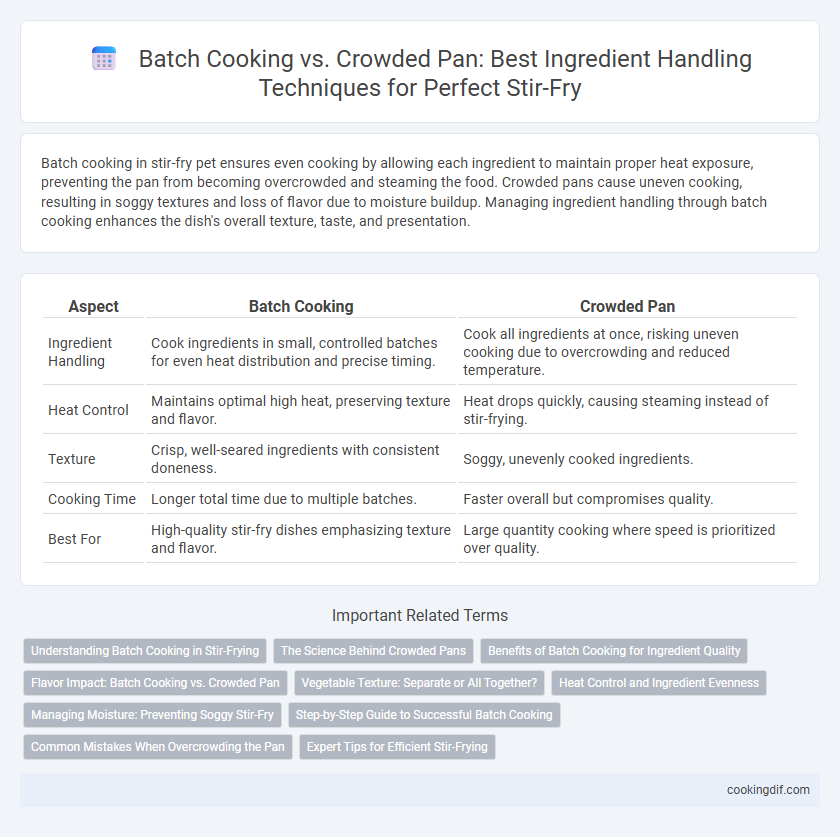Batch cooking in stir-fry pet ensures even cooking by allowing each ingredient to maintain proper heat exposure, preventing the pan from becoming overcrowded and steaming the food. Crowded pans cause uneven cooking, resulting in soggy textures and loss of flavor due to moisture buildup. Managing ingredient handling through batch cooking enhances the dish's overall texture, taste, and presentation.
Table of Comparison
| Aspect | Batch Cooking | Crowded Pan |
|---|---|---|
| Ingredient Handling | Cook ingredients in small, controlled batches for even heat distribution and precise timing. | Cook all ingredients at once, risking uneven cooking due to overcrowding and reduced temperature. |
| Heat Control | Maintains optimal high heat, preserving texture and flavor. | Heat drops quickly, causing steaming instead of stir-frying. |
| Texture | Crisp, well-seared ingredients with consistent doneness. | Soggy, unevenly cooked ingredients. |
| Cooking Time | Longer total time due to multiple batches. | Faster overall but compromises quality. |
| Best For | High-quality stir-fry dishes emphasizing texture and flavor. | Large quantity cooking where speed is prioritized over quality. |
Understanding Batch Cooking in Stir-Frying
Batch cooking in stir-frying improves ingredient handling by allowing more even cooking and better control over heat distribution. Crowded pans lower the temperature, causing ingredients to steam rather than fry, which compromises texture and flavor. Separating ingredients into smaller batches prevents moisture buildup and ensures optimal caramelization and crispness.
The Science Behind Crowded Pans
Crowded pans trap steam, leading to increased moisture and reduced Maillard reaction, which inhibits proper browning and flavor development in stir-fry dishes. Batch cooking controls pan temperature more effectively by allowing even heat distribution, enhancing caramelization and texture. Scientific understanding of steam dynamics and heat transfer emphasizes that avoiding overcrowding is essential for optimal stir-fry ingredient handling and taste.
Benefits of Batch Cooking for Ingredient Quality
Batch cooking in stir-fry preserves ingredient texture and flavor by preventing overcrowding, which often leads to steaming instead of frying. Cooking ingredients in smaller amounts ensures even heat distribution, resulting in crisp vegetables and perfectly seared proteins. This method enhances overall dish quality and maintains vibrant colors and distinct tastes.
Flavor Impact: Batch Cooking vs. Crowded Pan
Batch cooking preserves distinct ingredient flavors by preventing steaming and uneven cooking, resulting in a more vibrant and well-defined taste profile. In contrast, overcrowding the pan traps moisture, causing ingredients to steam rather than sear, which can dilute flavors and create a soggy texture. Proper ingredient handling through batch cooking enhances the Maillard reaction, delivering richer, caramelized flavors essential for an authentic stir-fry experience.
Vegetable Texture: Separate or All Together?
Batch cooking preserves vegetable texture by allowing each ingredient to cook evenly without steaming, preventing sogginess and maintaining crispness. Crowding the pan forces vegetables to release moisture, resulting in a steamed, softer texture rather than a stir-fried crispness. For optimal vegetable texture in stir-fries, cooking ingredients separately retains individual flavors and firmness.
Heat Control and Ingredient Evenness
Batch cooking in stir-fry ensures consistent high heat and prevents temperature drops, promoting even cooking and better ingredient texture. Overcrowding the pan traps steam, reducing heat intensity and causing unevenly cooked vegetables and proteins. Maintaining proper heat control by cooking in smaller batches preserves ingredient crispness and flavor balance.
Managing Moisture: Preventing Soggy Stir-Fry
Batch cooking prevents moisture buildup by cooking ingredients in smaller quantities, ensuring high heat retention and crisp texture. Overcrowding the pan traps steam, causing vegetables and proteins to release excess water and turn soggy. Managing moisture effectively requires leaving sufficient space for evaporation, maintaining optimal stir-fry heat levels, and cooking ingredients separately when necessary.
Step-by-Step Guide to Successful Batch Cooking
Batch cooking in stir-fry ensures even cooking by dividing ingredients into manageable portions, preventing overcrowding that causes steaming instead of searing. Begin by preheating the wok until smoking hot, then cook each batch quickly with high heat and constant stirring for optimal caramelization. Allow cooked batches to rest briefly off heat before combining to retain texture and flavor balance throughout the dish.
Common Mistakes When Overcrowding the Pan
Overcrowding the pan during stir-fry leads to steaming rather than searing, causing ingredients to release excess moisture and lose their crisp texture. Common mistakes include adding too many ingredients at once, which lowers the pan temperature and results in uneven cooking. Proper batch cooking helps maintain high heat, ensuring each ingredient is cooked quickly and retains vibrant color and flavor.
Expert Tips for Efficient Stir-Frying
Batch cooking prevents overcrowding, ensuring high heat retention and even ingredient caramelization essential for authentic stir-fry texture. Crowded pans cause steaming, leading to soggy vegetables and uneven cooking, compromising flavor and texture. Experts recommend using a wok or large skillet with high heat, cooking ingredients in small batches, and combining them at the end to maintain crispness and vibrant colors.
Batch cooking vs Crowded pan for ingredient handling Infographic

 cookingdif.com
cookingdif.com